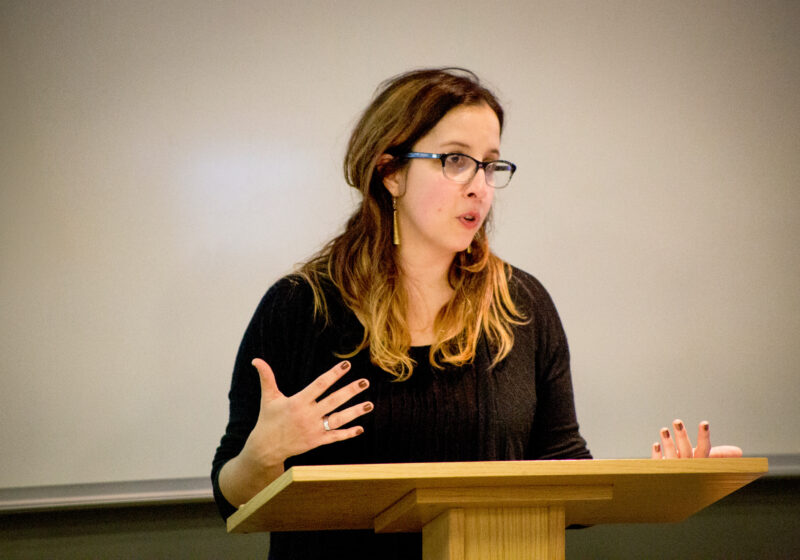New Professor of Chemistry Harry Stern recently received a grant of $50,000 from the Camille and Henry Dreyfus Foundation. This grant will be used to further advance the computer modeling of G Protein Coupled Receptors (GPCRs), a significant subject in today’s pharmaceutical research. Stern is regarded as an excellent addition to UR. “We have high expectations that Professor Stern will develop a nationally and internationally recognized research program in biomolecular simulations,” Chairman of the Department of Chemistry and Professor Robert Boeckman said. Boeckman nominated Stern for the 2004 New Faculty Award, which has nine total recipients around the United States. This specific Camille and Henry Dreyfus Foundation award is open to first-year professors on a tenure track who have proposed a research project focusing on chemistry, biochemistry or chemical engineering. “Professor Stern plans to model biological processes using mathematical models, much in the same way weather simulations are done,” Boeckman said. “A mathematical model is developed and applied to the biological macromolecules in question and the results of the simulation are compared to the actual behavior.” “The proposed research is to perform computer simulations of GPCRs in order to understand, at the atomic level of detail, how they [cells] respond to a signal,” Stern said. “Almost all cells respond to signals, either from other cells in the organism or from the outside world. For instance, the presence of a small molecule called a neurotransmitter causes a nerve cell to fire. In many cases, signals are recognized by specialized receptor proteins.” “It is believed that when the signal molecule binds to the receptor, the receptor changes its shape in such a way that it can then interact with other proteins on the inside of the cell,” he added. “We would like to understand how the signal molecule causes this change in shape.” According to Stern, about half of all known drugs work through GPCRs. An example is a type of drug referred to as “beta blockers,” which are prescribed for cardiovascular diseases. “Remarkably, despite being involved in a wide diversity of physiological functions, all GPCRs are believed to have a similar molecular structure,” he said. Stern explained that GPCRs are proteins that live within the cell membrane and are therefore very difficult to work with experimentally. “Out of thousands of members of the GPCR family, the atomic structure has been determined for only one, rhodopsin, which is found in the retina and which responds to light,” he said. “At present, computer simulations of large molecules such as GPCRs are still rather crude and inaccurate and not necessarily taken seriously by experimentalists,” Stern said. “I’ve always been fascinated by computers and computer simulations. It would make me happy to show that simulations can make a real contribution toward understanding an important problem,” he added.According to Boeckman, Stern will use an equilibrium statistical mechanical simulation in order to more clearly define biological processes.”Molecules are large enough that they have dual properties, the non-linear type determined by their quantum states and classical properties that can be described by the mechanics of objects of Newton, which works for macroscopic objects such as an apple,” Boeckman said. “Statistical mechanics allow chemists to relate the microscopic properties of individual molecules to the macroscopic behavior of the substance, which is composed of those molecules,” Boeckman continued. “The classical model then is used to simulate the measurable macroscopic behavior of an ensemble of molecules. It doesn’t simplify biological processes, it allows us to understand the microscopic behavior involved in biological processes in terms of measurable macroscopic properties.”Stern said that his graduate and post-doctoral work focused on computer simulations of simple systems, such as water or very small proteins, and he believes his proposed research will be based on similar skills. “I think the best thing about chemistry is that it touches upon and is crucial to so many different fields – materials science, biology, engineering and medicine to name a few,” he said. “No other discipline is so much at the heart of all science. I studied physics as an undergraduate, and didn’t make the switch to chemistry until graduate school, but I have never looked back,” Stern said. Welzer can be reached atbwelzer@campustimes.org.
Israel-Palestine
Conversations that matter: Nora Rubel’s hope of shaping future political discourse on Israel and Palestine
Interpreted by some as an anti-Israel and anti-Zionist series, Rubel emphasized that while the need to support a particular side passionately is understandable, it is crucial to be aware of what you are standing behind by exposing yourself to historical and present knowledge.
Antisemitism
The ‘wanted’ posters at the University of Rochester are unambiguously antisemitic. Here’s why.
As an educator who is deeply committed to fostering an open, inclusive environment and is alarmed by the steep rise in antisemitic crimes across this country and university campuses, I feel obligated to explain why this poster campaign is clearly an expression of antisemitism
Features
Whatever happened to the dormitories of yesteryear?
Two images come to mind: One is of cinder block-walled rooms hidden behind brutalist edifices, and the other is of air-conditioned suites bathed in natural light.



